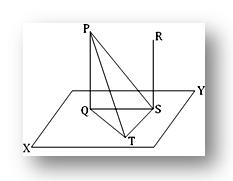Subscribe to our ▶️ YouTube channel 🔴 for the latest videos, updates, and tips.
Theorem on Parallel Lines and Plane
Theorem on parallel lines and plane are explained step-by-step along with the converse of the theorem.
Theorem: If two straight lines are parallel and if one of them is perpendicular to a plane, then the other is also perpendicular to the same plane.
Let PQ and RS be two parallel straight lines of which PQ is perpendicular to the plane XY. We are to prove that the straight line RS is also perpendicular to the plane XY.
Construction: Let us assume straight line PQ and RS intersect the plane XY at Q and S respectively. Join QS. Evidently, QS lies in the XY plane. Now, through S draw ST perpendicular to QS in the XY plane. Then, join QT, PT and PS.
Proof: By construction, ST is perpendicular to QS. Therefore, from the right-angled triangle QST we get,
QT² = QS² + ST² ………………(1)
Since PQ is perpendicular to the plane XY at Q and the straight lines QS and QT lie in the same plane, therefore PQ is perpendicular to both the lines QS and QT. Therefore, from the right-angle PQS We get,
PS ² = PQ ² + QS ² ………………(2)
And from the right-angle PQT we get,
PT² = PQ² + QT² = PQ² + QS² + ST² [using (1)]
or, PT² = PS² + ST² [using (2)]
Therefore, ∠PST = 1 right angle. i.e., ST is perpendicular to PS. But by construction, ST is perpendicular to QT.
Thus, ST is perpendicular to both PS and QS at S.
Therefore, ST is perpendicular to the plane PQS, containing the lines PS and QS.
Now, S lies in the plane PQS and RS is parallel to PQ; hence, RS lies in the plane of PQ and PS i.e., in the plane PQS. Since ST is perpendicular to the plane PQS at S and RS lies in this plane, hence ST is perpendicular to RS i.e., RS is perpendicular to ST.
Again, PQ and RS are parallel and ∠PQS = 1 right angle.
Therefore, ∠RSQ = 1 right angle i.e., RS is perpendicular to QS. Therefore, RS is perpendicular to both QS and ST at S; hence, RS is perpendicular to the plane containing QS and ST i.e., perpendicular to the XY.
Converse of the theorem on parallel lines and plane:
If two straight line are both perpendicular to a plane then they are parallel.
Let two straight lines PQ and RS be both perpendicular to the plane XY. We are to prove that the lines PQ and RS are parallel.
Following the same construction as in theorem on parallel lines and plane, it can be proved that ST is perpendicular to PS. Since, RS is perpendicular to the plane XY, hence RS is perpendicular to TS, a line through S in the plane XY i.e., TS is perpendicular to RS. Again, by construction, TS is perpendicular QS. Therefore, TS is perpendicular to each of the straight lines QS, PS and RS at S. hence, QS, PS and RS are co-planar (by theorem on co-planar). Again, PQ, QS and PS are co-planar (Since they lie in the plane of the triangle PQS). Thus, PQ and RS both lie in the plane of PS and QS i.e., PQ and RS are co-planar.
Again, by hypothesis,
∠PQS = 1 right angle and ∠RSQ = 1 right angle.
Therefore, ∠PQS + ∠RSQ = 1 right angle + 1 right angle = 2 right angles.
Therefore, PQ is parallel to RS.
● Geometry
- Solid Geometry
- Worksheet on Solid Geometry
- Theorems on Solid Geometry
- Theorems on Straight Lines and Plane
- Theorem on Co-planar
- Theorem on Parallel Lines and Plane
- Theorem of Three Perpendiculars
- Worksheet on Theorems of Solid Geometry
11 and 12 Grade Math
From Theorem on Parallel Lines and Plane to HOPME PAGE
Didn't find what you were looking for? Or want to know more information about Math Only Math. Use this Google Search to find what you need.



New! Comments
Have your say about what you just read! Leave me a comment in the box below. Ask a Question or Answer a Question.